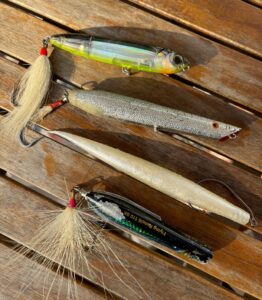Halfway through the upswing of my cast, I heard a snap and watched my silvery popper fly lazily overhead and plop in the fast-moving water a few dozen yards in front of me. I looked at the limp, lure-less leader dangling from the tip of my rod. The telltale curl at its end indicated the knot that had once secured the quick-change snap to the lure had unraveled. Not surprising, I guess. After all, I had caught perhaps a hundred large bass this year with that rod.
I watched the popper bob as it floated away into Wellfleet Harbor, a hard knot growing in the pit of my stomach behind my wader belt as I hoped that whoever found it lying on a beach would appreciate its true value.
Just before that cast, I had seen a small school of big stripers crash into a pod of menhaden. Following the rule “when fish are on top, you fish on top,” I had put on my favorite lure, that eight-inch Cotton Cordell popper. It wasn’t the lure’s $16 price that bothered me. Some lures, Cotton Cordell included, can be hard to find. But there was more to my sense of loss than the difficulty of finding another one like it.

That lure was a slice of my fishing history, the tangible evidence of dozens of strikes and hookups, with each hit leaving a gouge here, a rough spot there. After months of hard fishing, the lure had lost much of its luster but gained an attribute far more important than its fresh-out-of-the-package sheen. Over time, I realized, its reliability had spawned a confidence-building aura for me. That partially explained why I was feeling like a pitcher who, after striking out five batters, had witnessed his next pitch fly into the second row of the bleachers.
Not only emotions were involved. Such a setback can have physical consequences, too. Fishing requires speed and a large measure of confidence. There is no room for hesitation when the fish are breaking the surface in front of you. The speed with which you replace a lure is critical. More than speed, however, is the importance of making a perfect cast into a fast-moving school of fish.
As in any sport, success depends on one’s ability to rely, without thinking, on well-honed instincts. Confidence in those instincts results in choosing the right lure at the right time but also in making long, accurate casts. It is the embodiment of the power of positive thinking.
Losing a good lure is not like losing your wallet or phone. It’s more like finding out your very best fishing pal is moving out of town. It’s not necessarily a loss of friendship but it certainly is a diminishment of the shared history of so many fishing adventures.
Like go-to pals, go-to lures are hard to replace. A visit to any well-supplied tackle shop can be a confusing, even daunting experience. Each year the $16.8-billion fishing tackle industry comes up with hundreds of new offerings, often crowding out the lures you’ve come to rely on. Should you leave your tried-and-true lures for a newer model? Are you being tempted by slick and savvy marketing?
The basic shapes and purposes of every type of surface lure, swimmer, and jig haven’t changed much over the years. All are designed to mimic the shape, color, and motion of various forms of natural prey. None of these natural food sources have changed, and yet lures seem to evolve with every new fishing season. Lure construction materials have changed dramatically in recent years, with durable plastics and lifelike silicon forms replacing wood, fiberglass, and older plastics. Japanese lure makers have developed clear epoxy finishes that result in highly reflective and realistic color schemes. Such lures have an extraordinary depth of color and a lifelike quality that challenges even live bait in appearance.
I’m old school and not attracted by gimmicky designs. Years of experience have taught me that actively feeding fish, especially bluefish, will hit any properly presented lure. Three springs ago, likely due to Covid-induced shipping issues, none of my best lures were available. So, I was forced to try out a variety of lures, some of which have surprised me by making their way into the “favorites” pocket of my tackle bag. For example, I have discovered that large silicon Fish Snax lures are now my go-to for large stripers.
I have also learned that the realistic eye-popping finishes of Japanese lures, given enough of a chance to perform, get just as scuffed and worn as my old-school favorites. There’s comfort in that, and while I find my casts go just as far and are as accurate as ever, I still lament the loss of that particular sweet abraded and ever-deadly Cotton Cordell.



